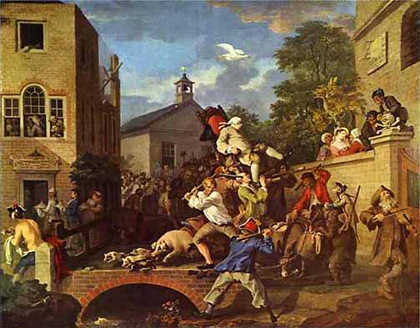Today marks the anniversary of the first secret ballot held in Great Britain, at the election of 1872. So this week’s picture is William Hogarth’s The Election: Chairing the Member, one of four paintings by the artist intended to expose the general corruption of the electoral process as it was in the mid-eighteenth century. The picture was painted exactly 250 years ago and it can be seen, together with the other three works in the series, at Sir John Soane’s Museum in London.
Hogarth was in the last decade of his life when he painted the “Election” series, which may be said to demonstrate the progressive darkening of his satire. Chairing the Member, with its bleak image of a corpulent victorious candidate, borne precariously aloft by the rabble that has elected him, helps to explain why the radical politician John Wilkes complained that Hogarth did not give enough place to benevolence in his view of the world. The series of which the work forms a part was inspired by the General Election of 1754, in particular the contest between the Whigs and the incumbent Tories in Oxfordshire, which was widely reported in the popular press of the time and became a byword for electoral corruption. As well as pamphleteering and speech-making, both sides also spent a great deal of money on providing “treats” for potential supporters and otherwise attempting to manipulate the vote in their favour. As Oliver Goldsmith put it in his Citizen of the World, “the merits of a candidate are often measured by the number of his treats; his constituents assemble, eat upon him, and lend their applause not to his integrity of sense but the quantities of his beef and brandy.”
Hogarth inveighed against such practices in the first of his paintings...


